Mauna Loa eruption - latest: Satellite captures view of advancing lava from space as crowds flock to volcano
Follow for the latest updates on Mauna Loa’s first eruption in 38 years
Your support helps us to tell the story
From reproductive rights to climate change to Big Tech, The Independent is on the ground when the story is developing. Whether it's investigating the financials of Elon Musk's pro-Trump PAC or producing our latest documentary, 'The A Word', which shines a light on the American women fighting for reproductive rights, we know how important it is to parse out the facts from the messaging.
At such a critical moment in US history, we need reporters on the ground. Your donation allows us to keep sending journalists to speak to both sides of the story.
The Independent is trusted by Americans across the entire political spectrum. And unlike many other quality news outlets, we choose not to lock Americans out of our reporting and analysis with paywalls. We believe quality journalism should be available to everyone, paid for by those who can afford it.
Your support makes all the difference.A satellite has captured stunning images of the Mauna Loa eruption from space, as crowds flock to the Hawaii volcano to watch the rare event.
The photos, taken when the eruption began on 28 November, were released after the US Geological Survey warned there was a “high probability” a stream of molten lava would reach a main highway on Hawaii’s Big Island.
Officials are preparing for the possibility that the Daniel K Inouye Highway, which connects the communities of Hilo and Kona, could be shut down within the week despite the flow slowing its advance.
“It’ll probably come around the north side of Pu’u Huluhulu, which is right at the Mauna Kea turnoff on Saddle Road,” said Ken Hon, Hawaiian Volcano Observatory scientist-in-charge, at a news conference Wednesday.
The lava flow was previously moving at a rate of 130 meters an hour, but as of Thursday night, Mr Hon confirmed that it had slowed to just 30 yards per hour as the lava hit flat terrain.
PHOTOS: Spectators flock to Hawaii to view eruption
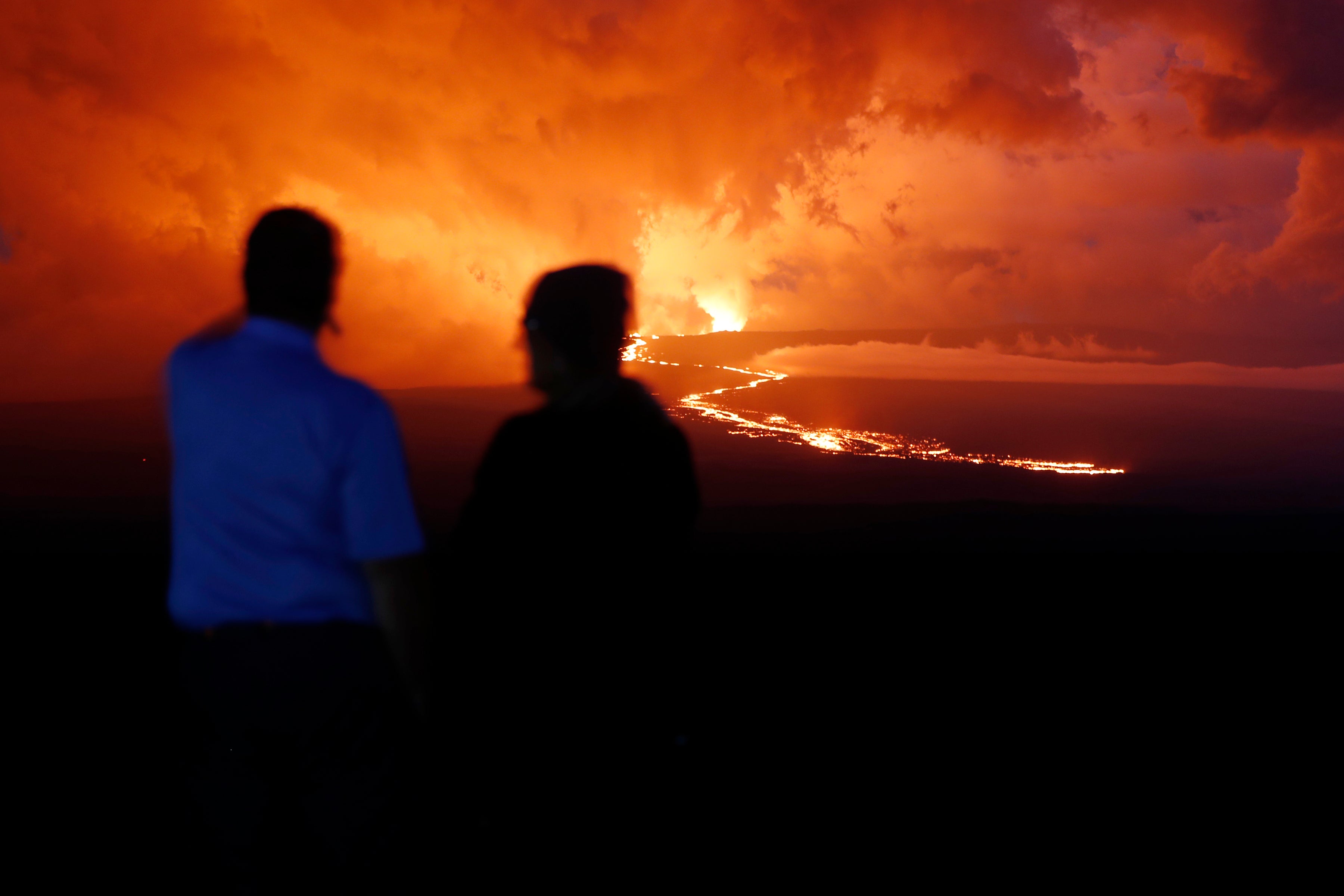
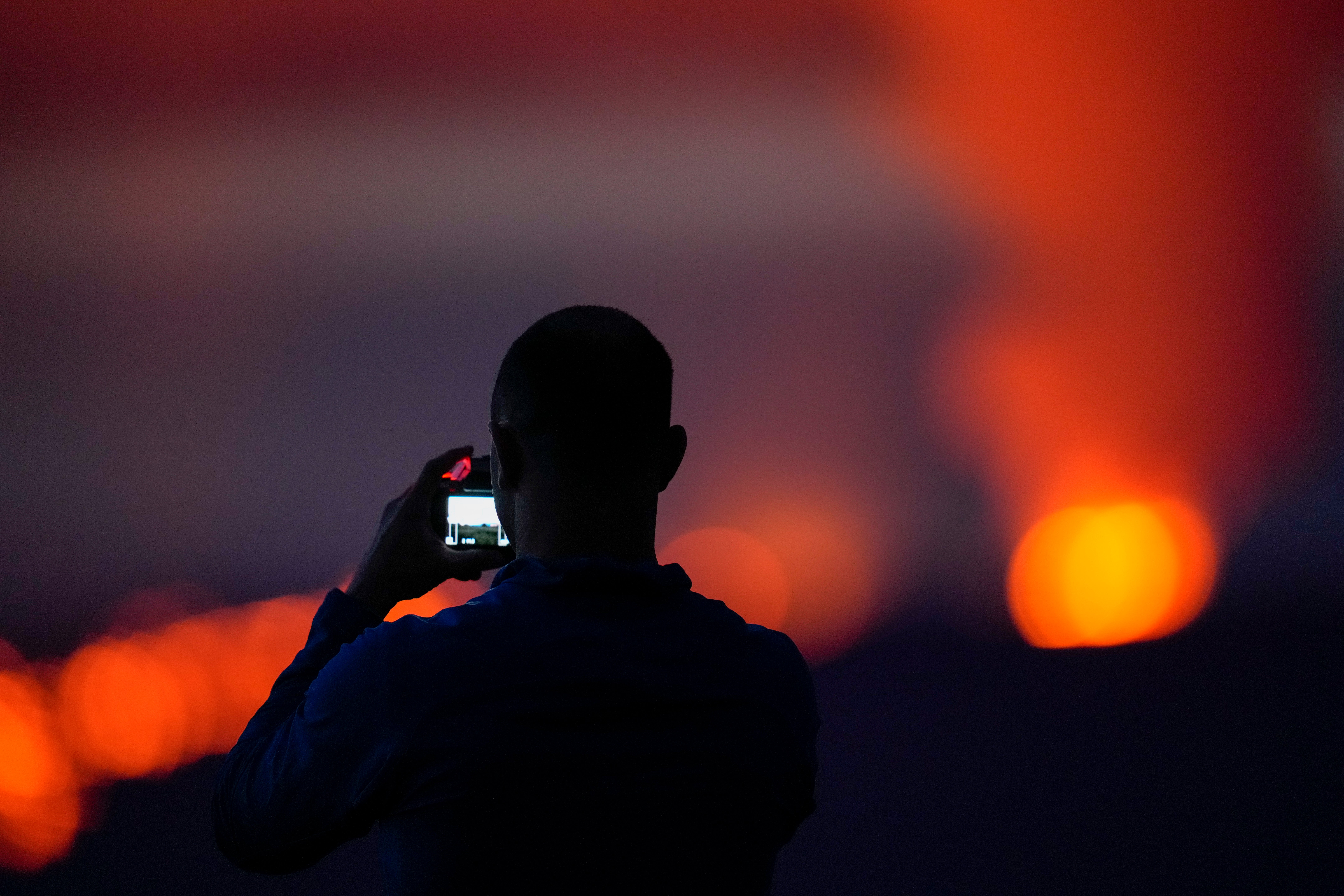

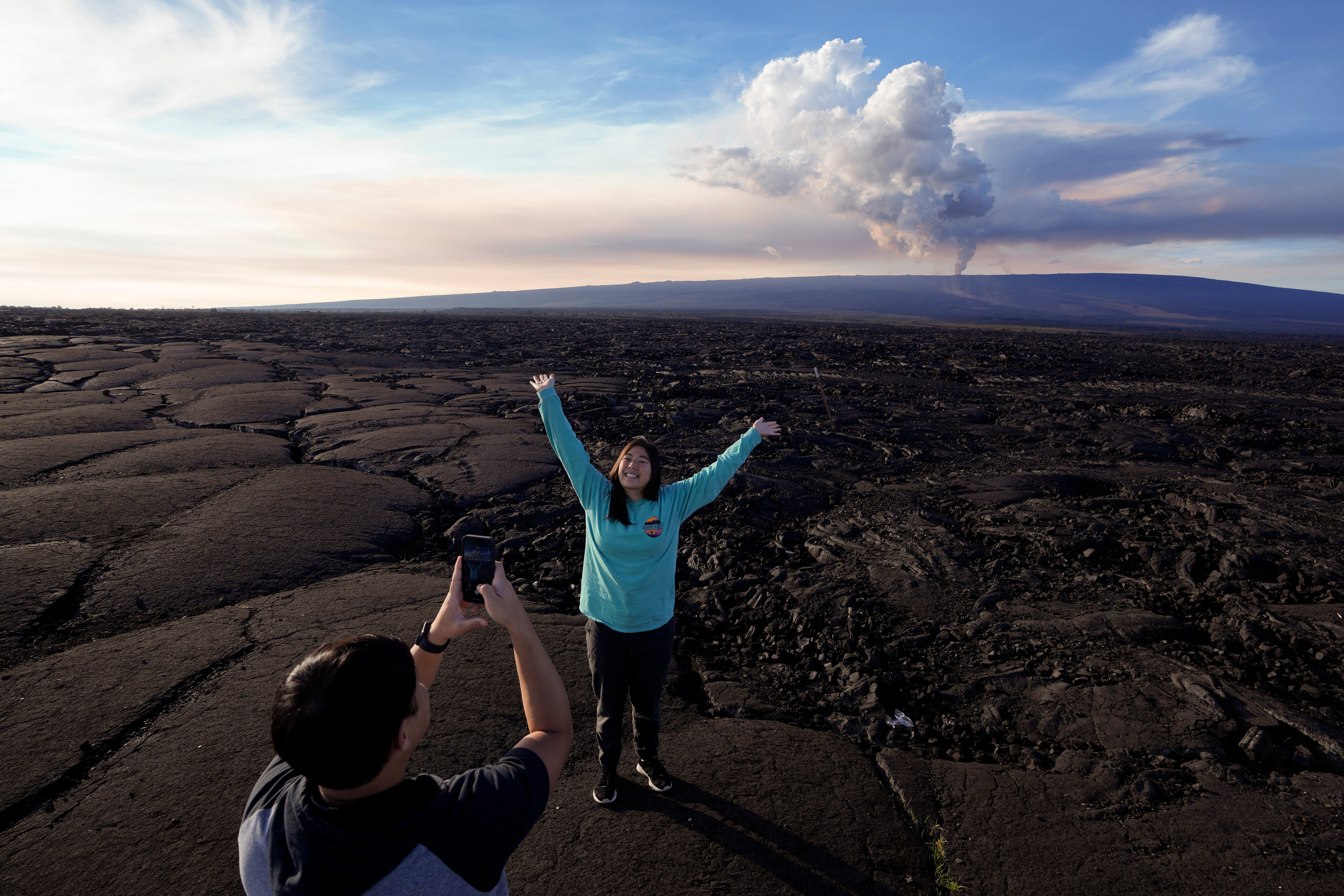
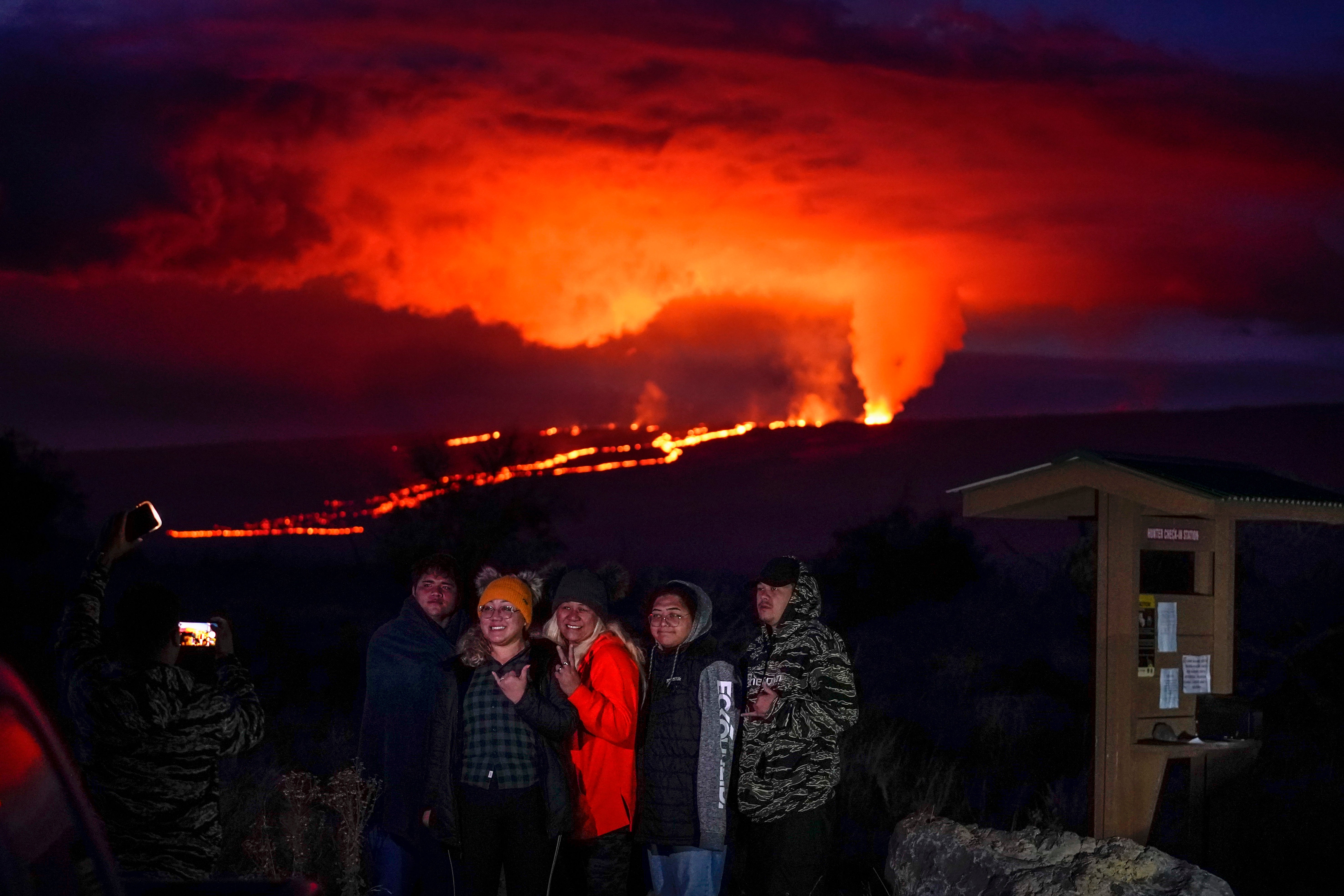
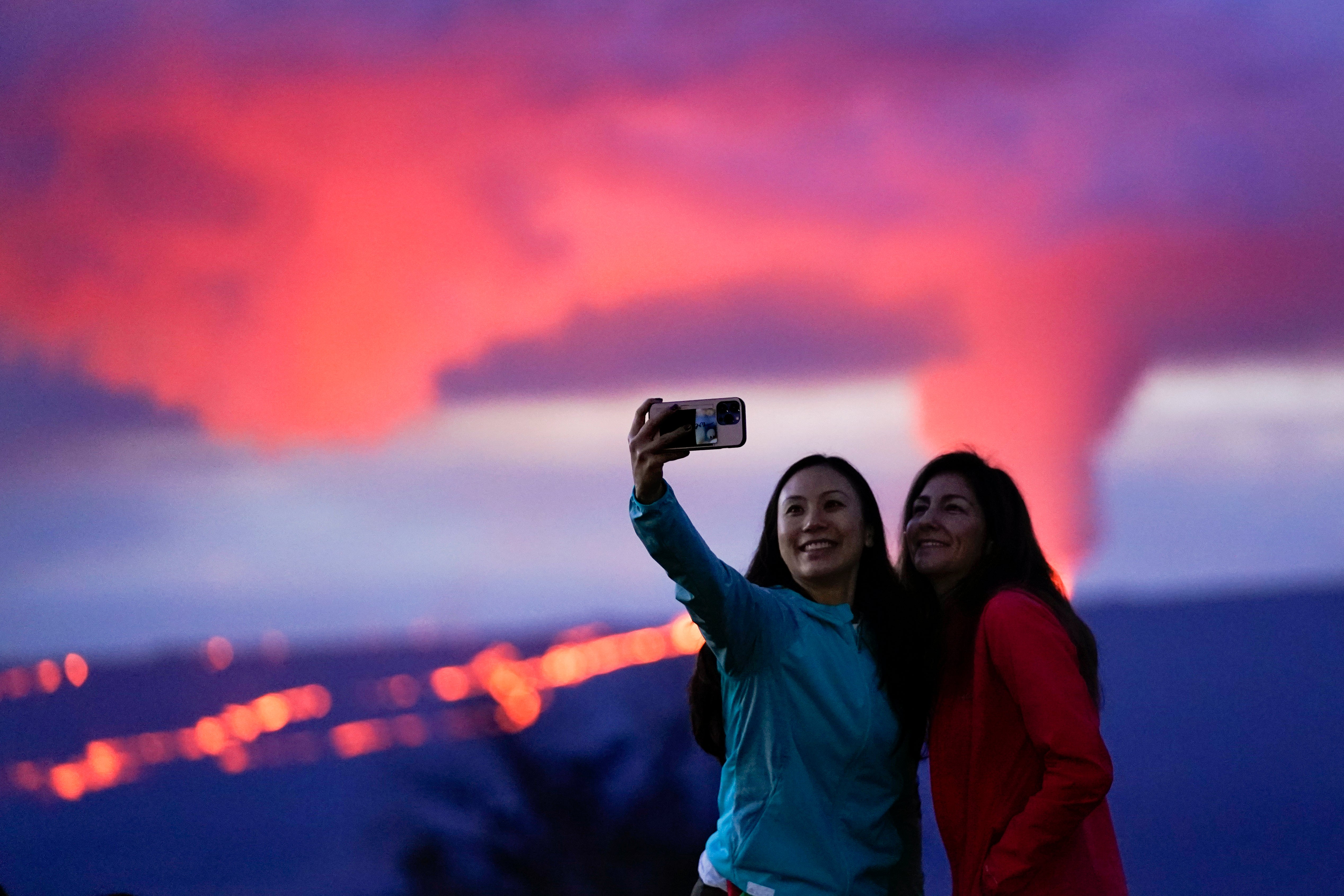
Lava tumbles slowly towards Saddle Road
The lava was tumbling slowly down the slope and was about 6 miles (10 kilometers) from the highway known as Saddle Road. It was not clear when, or if, it would cover the road, which runs through old lava flows.
The road bisects the island and connects the cities of Hilo and Kailua-Kona. People traveling between them would need to take a longer coastal road if Saddle Road becomes impassable, adding several hours of drive time.
Ken Hon, scientist in charge at the Hawaiian Volcano Observatory, said at current rate of flow, the soonest the lava would get to the road is two days, but he added that things could change.
Mauna Loa last erupted in 1984. The current eruption is its 34th since written record keeping began in 1843. Its smaller neighbor, Kilauea, has been erupting since September 2021, so visitors to the national park were being treated to the rare sight of two simultaneous eruptive events: the glow from Kilauea’s lava lake and lava from a Mauna Loa fissure.
Abel Brown, a visitor from Las Vegas, was impressed by the natural forces on display. He planned to take a close-up helicopter tour later in the day — but not too close.
USGS warns ‘high probability’ lava could reach highway
The US Geological Survey warned during a Wednesday evening press conference that there was a “high probability” that the lava crawling from the erupting Mauna Loa volcano could reach a main highway on Hawaii’s Big Island.
Officials are preparing for the possibility that the Daniel K Inouye Highway, which connects the communities of Hilo and Kona on the island, could be shut down within days as the molten lava continues to flow across the terrain.
“It’ll probably come around the north side of Pu’u Huluhulu, which is right at the Mauna Kea turnoff on Saddle Road,” said Ken Hon, Hawaiian Volcano Observatory scientist-in-charge, at a news conference Wednesday, according to Hawaii News Now.
The lava flow was previously moving at a rate of 130 meters an hour, which if maintained, means it could reach the main thoroughfare by Friday, the USGS said.
But as of 7pm local time on Wednesday, Mr Hon had confirmed that it had slowed to just 24 metres per hour, as the lava had hit a flat terrain.
“The terrain is what is slowing it down. There’s no doubt about it also getting more distant from vent... we’re seeing more crystal... they get hard and like block start providing resistance,” he explained.
Officials within the state were preparing for the seemingly inevitable shutdown of the highway as they mapped out routes for diverting traffic, if needed.
Hawaii Governor David Ige had previously said that, should this shutdown come, he plans to activate the Hawaii National Guard to help set up critical infrastructure and “support planning for alternative routes and help with making available bypass routes if that becomes necessary.”
‘Spectacular’: Tourists flock to Hawaii to see volcano erupting for first time in 38 years
Tourists have flocked to Hawaii to witness the world’s largest active volcano erupting, with fountains of lava being spewed out reaching over 100 feet high.
This is the first eruption of Mauna Loa in 38 years, with eruptive activity at the site last seen in 1984. Smaller nearby volcano, Kilauea, has been erupting since 2021, so both can be viewed from Hawaii Volcanoes National Park.
The park is open 24 hours a day and, as reported by Stuff, tourists have seen the best views at night and before sunrise.
Spokesperson for the National Park, Jessica Ferracane, said: “The viewing has been spectacular,” before adding that, “this is a rare time where we have two eruptions happening simultaneously.”
Hawaii governor says he plans to activate National Guard if lava reaches highway
As a stream of molten lava continues inching towards a main highway on Hawaii’s Big Island, threatening to shut down the thoroughfare and reroute traffic between two main communities, officials in the state are saying they’re urging residents to be prepared for delays.
Hawaii Governor David Ige said Wednesday that he plans to activate the Hawaii National Guard to help set up critical infrastructure and “support planning for alternative routes and help with making available bypass routes if that becomes necessary.”
Ed Sniffen, the deputy director of highways for the state department of transportation, confirmed that the state’s agencies are preparing for a probably necessary shut down when and if the lava reaches the highway, known more commonly as Saddle Road.
“All the equipment necessary to shut down the road where it was necessary, to put a message board, so we can alert everyone in advance of the shutdowns, and that we can clear the Hamakua coast of any lane restrictions that we have on that area,” said Mr Sniffen.
Volcano knocks Mauna Loa carbon monitoring station offline
The eruption of Hawaii‘s Mauna Loa volcano has temporarily knocked off power to the world’s premier station that measures heat-trapping carbon dioxide in the atmosphere, but officials Wednesday say it won’t be a problem.
There are hundreds of other carbon dioxide monitoring sites across the globe. The federal government is looking for a temporary alternate site on the Hawaiian island and is contemplating flying a generator to the Mauna Loa observatory to get its power back so it can take measurements again, said officials at the National Oceanic and Atmospheric Administration’s Global Monitoring Lab in Colorado that operates the station.
The Hawaiian station goes back to 1958 and is the main site for the famous Keeling Curve that shows rising carbon dioxide levels from burning of coal, oil and natural gas that tracks with rising temperatures. Levels of carbon dioxide at Mauna Loa have increased 33% since 1958.
The station at 11,300 feet high (3,444 meters), has a 131-foot (40-meter) tower that collects air to measure levels of carbon dioxide, radiation and other materials. Even though the flow of lava isn’t near the station it cut off power lines further down the mountain, officials said.
“This is sort of our flagship station,” said Colm Sweeney, the monitoring lab’s associate director. “The scientific value of Mauna Loa is really in what it stands for. It also is one of the cleanest signals that we have.”
Read more:

Volcano knocks Mauna Loa carbon monitoring station offline
The eruption of Hawaii’s Mauna Loa volcano has temporarily knocked off power to the world’s premier station that measures heat-trapping carbon dioxide in the atmosphere
VIDEO: Mauna Loa volcano spews lava in mesmerising flyover footage
Mesmerising footage captured from the skies shows Mauna Loa volcano spewing ash and lava into the air.
The world’s largest active volcano started erupting on Sunday night (27 November) in Hawaii for the first time in 38 years.
No populated areas were under threat, the US Geological Survey said on Monday, but officials will provide ongoing updates if that changes.
Dozens of earthquakes were triggered by the eruption, one of a 4.2 magnitude on the Richter scale.
USGS finds Pele’s hairs many kilometres away from erupting volcano fissures
The USGS confirmed on Wednesday that a geology field team had already begun finding Pele’s hairs - volcanic glass formation made from cooled lava stretched into thin strands - many kilometres away from the erutping fissures on Mauna Loa.
“#HVO‘s geology field team reports they are finding Pele’s hairs (small filaments of quenched lava) draped across older lava flows near Saddle Road, just past Pu‘u Huluhulu cinder cone. Hairs deposited many km (mi) from active vents by the windblown eruption plume,” tweeted the USGS on Wednesday.
Governor concerned about car accidents as tourists flock to island to catch sight of rare volcano eruption
Hawaii Governor David Ige has reiterated that it’s “completely safe” to come visit the state’s Big Island to catch a glimpse of Mauna Loa’s eruption, noting that since the “eruption site is high up the mountain, and it’s in a relatively isolated location.”
But the Gov Ige has cautioned that the uptick in tourists on the island, particularly as main highways are at risk of being shutdown, could increase the risk for another kind of hazard: car accidents.
“We are concerned because visitors and residents are stopping along the highway, and sometimes drivers are not paying attention fully,” he said, adding that distracted drivers gawking at the volcano and drivers parking illegally on main thoroughfares could create a potentially lethal combination.
For instance, just hours after Big Island Mayor Mitch Roth banned parking alongside the highway, a car was hit as it was driving off the shoulder to the main road.
Parking along the road is currently prohibited between mile markers 16 to 31, and any vehicles left there could be towed or ticketed with a $1,000 fine.
“So we are concerned about traffic control on the highway,” added Gov Ige.
USGS warns ‘high probability’ lava could reach highway
The US Geological Survey warned during a Wednesday evening press conference that there was a “high probability” that the lava crawling from the erupting Mauna Loa volcano could reach a main highway on Hawaii’s Big Island.
Officials are preparing for the possibility that the Daniel K Inouye Highway, which connects the communities of Hilo and Kona on the island, could be shut down within days as the molten lava continues to flow across the terrain.
“It’ll probably come around the north side of Pu’u Huluhulu, which is right at the Mauna Kea turnoff on Saddle Road,” said Ken Hon, Hawaiian Volcano Observatory scientist-in-charge, at a news conference Wednesday, according to Hawaii News Now.
The lava flow was previously moving at a rate of 130 meters an hour, which if maintained, means it could reach the main thoroughfare by Friday, the USGS said.
But as of 7pm local time on Wednesday, Mr Hon had confirmed that it had slowed to just 24 metres per hour, as the lava had hit a flat terrain.
“The terrain is what is slowing it down. There’s no doubt about it also getting more distant from vent... we’re seeing more crystal... they get hard and like block start providing resistance,” he explained.
Officials within the state were preparing for the seemingly inevitable shutdown of the highway as they mapped out routes for diverting traffic, if needed.
Hawaii Governor David Ige had previously said that, should this shutdown come, he plans to activate the Hawaii National Guard to help set up critical infrastructure and “support planning for alternative routes and help with making available bypass routes if that becomes necessary.”
Subscribe to Independent Premium to bookmark this article
Want to bookmark your favourite articles and stories to read or reference later? Start your Independent Premium subscription today.





Join our commenting forum
Join thought-provoking conversations, follow other Independent readers and see their replies
Comments